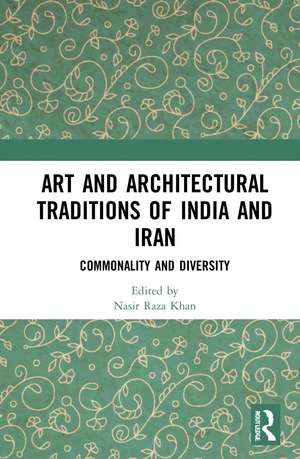Art and Architectural Traditions of India and Iran: Commonality and Diversity
Editat de Nasir Raza Khanen Limba Engleză Paperback – 25 sep 2023
With its archival sources, this book will be useful to scholars and researchers of medieval history, Indian history, international relations, Central Asian history, Islamic studies, Iranian history, art and architecture, heritage studies, cultural studies, regional studies, and South Asian studies as well as those interested in the study of sociocultural and religious exchanges.
| Toate formatele și edițiile | Preț | Express |
|---|---|---|
| Paperback (1) | 385.25 lei 6-8 săpt. | |
| Taylor & Francis – 25 sep 2023 | 385.25 lei 6-8 săpt. | |
| Hardback (1) | 1002.68 lei 6-8 săpt. | |
| Taylor & Francis – 30 noi 2021 | 1002.68 lei 6-8 săpt. |
Preț: 385.25 lei
Nou
Puncte Express: 578
Preț estimativ în valută:
73.72€ • 78.83$ • 61.46£
73.72€ • 78.83$ • 61.46£
Carte tipărită la comandă
Livrare economică 17 aprilie-01 mai
Preluare comenzi: 021 569.72.76
Specificații
ISBN-13: 9781032134819
ISBN-10: 103213481X
Pagini: 244
Ilustrații: 2 Tables, black and white; 9 Line drawings, black and white; 27 Halftones, black and white; 36 Illustrations, black and white
Dimensiuni: 156 x 234 x 13 mm
Greutate: 0.35 kg
Ediția:1
Editura: Taylor & Francis
Colecția Routledge India
Locul publicării:Oxford, United Kingdom
ISBN-10: 103213481X
Pagini: 244
Ilustrații: 2 Tables, black and white; 9 Line drawings, black and white; 27 Halftones, black and white; 36 Illustrations, black and white
Dimensiuni: 156 x 234 x 13 mm
Greutate: 0.35 kg
Ediția:1
Editura: Taylor & Francis
Colecția Routledge India
Locul publicării:Oxford, United Kingdom
Public țintă
PostgraduateCuprins
Introduction Part I: A Confluence of Traditions 1. The Qutb Complex: Iran and India 2. Mapping the Overlap between the Culture of Iranian "Turquoise and Emerald" with Indian "Saffron and Vermillion" 3. The Transition of the Khāksār to the Nāth Yogi via Gor Khatri 4. Caravanserais: A Synthesis of Indo-Iranian Architecture 5. Nuskha-i-Shah Jahani, A Confluence of Indo-Persian Food Culture 6. Myth and Mythology Related to Water in Indian and Iranian Culture: Connections and Continuity Part II: Regional Dynamics 7. The Mughal Gardens of Kashmir: A Cultural Perspective 8. Transformation of a "Hindu" City into a "Muslim" Capital? Factual and Fabled Mohammadabad Champaner under the Sultans of Gujarat 9. The Major Mughal Buildings of Thatta in the Seventeenth Century: A Synthesis of Central Asian, Classical Mughal and Local Architecture 10. Development of Kashmir’s Islamic Religious Architecture in the Medieval Period: Synthesis and Continuity Part III: India and Iran: Historical Perspectives 11. Imperative Role of Nur Jahan and her Persian Roots in the Evolution of Mughal Garden Tombs 12. Impact of Persian Ghazals on Mughal Monuments 13. Shaikh Abdul Haq: A Traditionalist of Bokhara in Delhi 14. Following the Traces of the Great Migration of Turks from Asia to Anatolia 15. Cultural and Architectural Engagements between India and Iran: A Study of Indian Literature Through the Ages
Notă biografică
Nasir Raza Khan is Associate Professor in the India-Arab Cultural Centre, Jamia Millia Islamia, New Delhi, India. He was former Visiting Professor (ICCR Chair) at the Lebanese American University, Beirut, Lebanon, and Former Director of the L.B. Shastri Centre for Indian Culture, Embassy of India, Tashkent, Uzbekistan.
Recenzii
‘A wide-ranging examination of the longstanding links between Iran and India in Islamic times, from the well-known arts of building, landscape architecture and painting to many other aspects of daily life including dress, food, music and verse, this book is bound to appeal to a broad audience interested in intercultural exchange.’
Sheila Blair, Norma Jean Calderwood University Professor of Islamic and Asian Art (Emerita), Boston College, MA, USA
‘This timely and richly varied collection of essays delves into the long and entangled history of connections between India and Iran. Viewed through the historical lens of cultural landscapes, rather than the dividing boundaries of the nation-state structures we are accustomed to, these essays focus on different aspects of the staggeringly diverse ways the peoples from West Asia, through Central and South Asia of today lived in cultural worlds that did not label things Indian, Afghan, Iranian, or Hindu and Muslim, but remained open to transregional and transcultural flow of ideas, tastes, and technologies.’
Sussan Babaie, Professor, Islamic and Iranian Arts, The Courtauld Institute of Art, London, UK
Sheila Blair, Norma Jean Calderwood University Professor of Islamic and Asian Art (Emerita), Boston College, MA, USA
‘This timely and richly varied collection of essays delves into the long and entangled history of connections between India and Iran. Viewed through the historical lens of cultural landscapes, rather than the dividing boundaries of the nation-state structures we are accustomed to, these essays focus on different aspects of the staggeringly diverse ways the peoples from West Asia, through Central and South Asia of today lived in cultural worlds that did not label things Indian, Afghan, Iranian, or Hindu and Muslim, but remained open to transregional and transcultural flow of ideas, tastes, and technologies.’
Sussan Babaie, Professor, Islamic and Iranian Arts, The Courtauld Institute of Art, London, UK
Descriere
This book presents a comprehensive overview of the historical and cultural linkages between India and Iran in terms of art and architectural traditions and their commonality and diversity.
